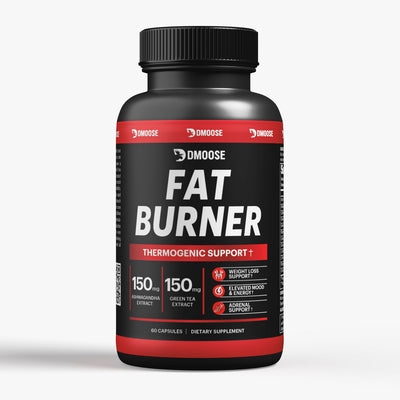Losing fat is one thing; keeping it off is a whole different challenge. How many times have you or someone you know lost weight only to regain it months later?
Most people rely on crash diets and extreme workouts that simply aren’t sustainable. They see temporary success, but the results never last.
But what if staying lean wasn’t about constant dieting? What if the leanest people weren’t struggling, but instead had daily habits that made fat loss effortless?
Inspired by Jeremy Ethier’s latest video, we’re breaking down the five key habits he emphasizes for getting lean and staying that way, and that too without suffering through restrictive diets or exhausting workout plans.
To further support your fat-burning process, consider incorporating the DMoose fat burner supplements into your routine.
1. Increase Activity and Fuel Your Body for Fat Loss

Most people believe that losing fat means eating less. However, Jeremy Ethier suggests that the leanest individuals often eat more while maintaining less body fat. The secret lies in maintaining a high energy flux, where you burn more calories through increased activity rather than extreme calorie restrictions.
Staying active doesn’t mean doing endless cardio. Instead, small, consistent movements throughout the day, like walking or taking the stairs, help create a high energy flux. Strength training also plays a major role, as more muscle means higher calorie burn even at rest. When you build a habit of moving frequently, fat loss becomes automatic.
How to Increase Your Energy Flux
- Walk more: Aim for 8,000–12,000 steps per day.
- Lift weights: Strength training helps you burn more calories at rest.
- Use active habits: Take the stairs, walk while on calls, and park further away.
- Incorporate short bursts of activity: Try the DMoose Heavy Jump Rope for quick, high-intensity cardio sessions.
Related Article: Easy At-Home Workout Moves for All Levels
2. Track Your Progress to Stay in Control of Your Fat Loss Journey

Would you try to save money without checking your bank account? Probably not. Yet, when it comes to fat loss, many people go in blindly without tracking progress. Jeremy Ethier stresses that successful fat loss comes from self-monitoring.
Tracking doesn’t mean obsessing over every calorie. Instead, it’s about gaining awareness of your habits. Consistently monitoring progress allows you to make small adjustments before things get off track. Even simple check-ins, like how your clothes fit or your strength in the gym, can be powerful indicators of progress.
What to Track?
- Body weight: Weigh yourself at least three times a week.
- Food intake: Know how much protein, carbs, and fats you’re consuming.
- Step count: Activity levels play a huge role in fat loss.
- Clothing fit: If your clothes fit better, you’re making progress, even if the scale doesn’t show it.
Related Article: How to Track Fitness Progress: 10 Ways to Meet Your Goals
3. Prioritize Sleep for Maximum Fat Loss

Poor sleep ruins fat loss efforts, yet most people ignore it. According to Jeremy Ethier, without proper sleep, your body struggles to burn fat, leading to muscle loss, poor workout performance, and increased hunger. A well-rested body is primed for fat loss, muscle growth, and optimal performance in the gym. When you prioritize sleep, your fat loss efforts become much easier and more effective.
Beyond just feeling tired, lack of sleep increases stress hormones that can cause the body to hold onto fat. Poor sleep also affects decision-making, making it more likely to crave junk food and skip workouts. Prioritizing sleep can make your fat loss journey significantly easier.
How to Improve Sleep Quality?
- Stick to a consistent bedtime and wake-up time.
- Avoid caffeine in the afternoon.
- Create a relaxing nighttime routine.
- Optimize your sleep environment (cool, dark, and quiet room).
4. Build Balanced Meals to Keep Your Body Fueled

Eating right doesn’t mean cutting out all your favorite foods. Jeremy Ethier emphasizes the importance of structuring meals in a way that fuels your body while keeping you full and satisfied. Consistently eating meals rich in these elements makes fat loss feel effortless while keeping you full and energized.
Balanced meals help regulate energy levels, reduce cravings, and improve workout performance. By focusing on nutrient-dense foods, you’ll avoid the cycle of energy crashes and binge eating. Consistency with high-quality meals is one of the easiest ways to stay lean long-term.
What Makes a High-Quality Meal?
- High-Quality Protein: Eggs, fish, Greek yogurt, chicken, or a protein shake with DMoose Whey Protein Powder.
- Fiber-Rich Vegetables: Crucial for satiety and digestion.
- Whole Grains or Healthy Fats: Brown rice, quinoa, avocado, or olive oil.
Also, with proper nutrition, you can develop abs. And for that, incorporate the DMoose Ab Roller to build a strong, lean midsection while eating mindfully.

5. Set Clear, Actionable Goals to Make Fat Loss Sustainable

Many people set vague fitness goals like “lose weight” or “eat healthier.” Jeremy Ethier suggests a structured approach called goal hierarchy, which focuses on daily actions rather than just outcomes. Breaking down goals this way shifts the focus from the outcome to the process, making long-term success inevitable.
Success comes from focusing on small daily actions rather than just big goals. Instead of only aiming to lose a certain amount of weight, break it down into what you’ll do daily like meal prepping or committing to workouts. This approach ensures progress stays steady and sustainable.
How to Set Up Your Goal Hierarchy
- Define Your Why: Example: “I want to be a healthy role model for my kids.”
- Set Your What: Example: “Eat healthier, exercise consistently, and sleep better.”
- Establish Your How: Example: “Weigh myself daily, meal prep twice a week, lift weights 3x a week, and walk 10,000 steps per day.”
FAQs
1. How long does it take to see results from these habits?
It depends on your starting point and consistency. Most people notice changes in 4–6 weeks, with significant progress in 12 weeks.
2. Can I lose fat without counting calories?
Yes! While tracking helps, focusing on portion control, whole foods, and hunger cues can also be effective.
3. Is fasted cardio necessary for fat loss?
No, fat loss is about total calorie balance. Whether you eat before or after cardio doesn’t significantly impact long-term results.
4. How do I stay motivated when progress slows down?
Track non-scale victories like strength gains, improved energy, and better sleep. Also, focus on the process rather than just the outcome.
5. Should I eat carbs if I want to get lean?
Yes! Carbs fuel your workouts and support muscle recovery. Just prioritize whole-food sources like sweet potatoes, rice, and oats.
6. Can supplements help with fat loss?
Supplements like the DMoose Fat Burner can support metabolism, but they work best when combined with a proper diet and exercise.
Final Thoughts: Start Small and Stay Consistent
Getting lean and staying lean isn’t about perfection; it’s about consistency. Start small, pick one habit to implement today, and build from there. The more you practice these habits, the easier they become.
Remember, progress isn’t always linear. There will be setbacks, but as long as you stay consistent, results will come. Keep focusing on the process, not just the outcome. With the right mindset and a structured approach, getting and staying lean becomes second nature.
Reading List
- Fat Loss & Getting Shredded Expert Guide
- Burn Calories: Top 8 Calorie-Burning Workouts
- A 12-Week Fat Destroyer: Complete Fat Loss Workout & Diet Program
- Does Working Out Increase Testosterone?
- What Researcher Says on Improving Your Immune System to Prevent Diseases | Complete Guide
- Vitamins and Minerals That You Should Take Daily











